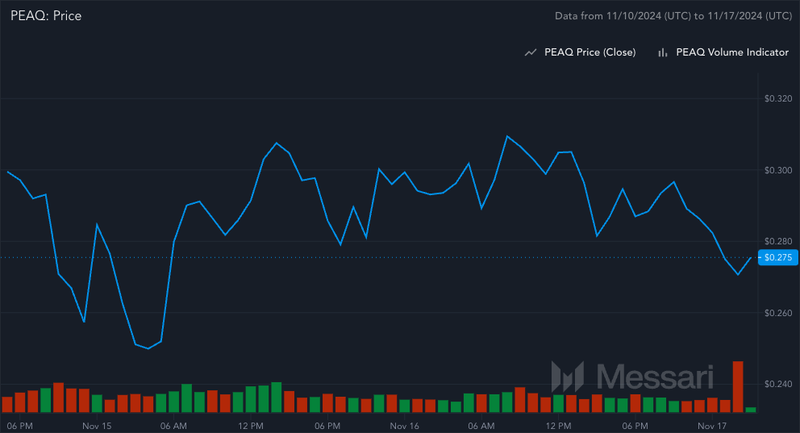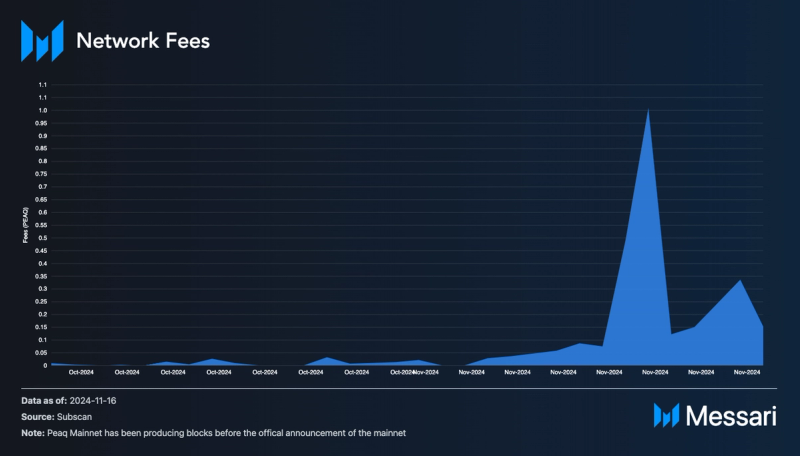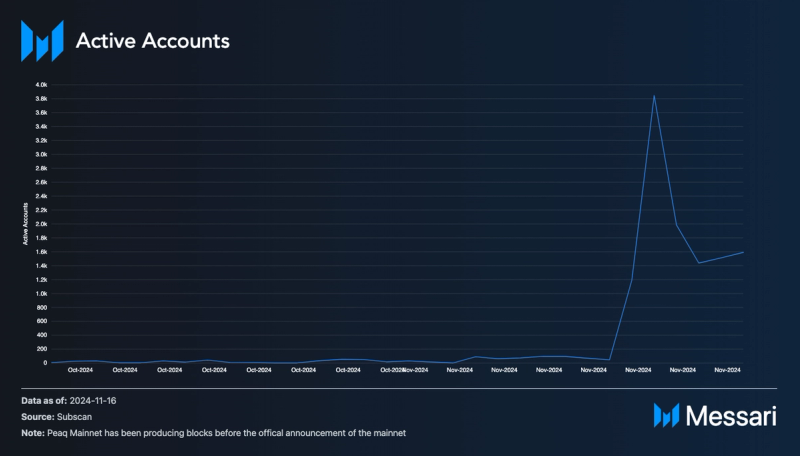Key Insights
- peaq launched its mainnet on November 12, 2024.
- peaq’s ecosystem launched with over 50 DePIN projects building on the network across 21 industries.
- peaq’s native utility token PEAQ, went live with the mainnet launch. PEAQ can be staked, pay for transaction fees, and will have governance capabilities.
- peaq features self-sovereign Machine IDs, which assign devices unique, blockchain-based identities. These identities enable secure and verifiable interactions.
Primer
peaq was founded in 2017 by Till Wendler, Leonard Dorlöchter, and Max Thake, who shared a vision of integrating blockchain technology with the Internet of Things (IoT). Recognizing the limitations of existing infrastructure, they set out to create a Layer-1 blockchain tailored to support decentralized, machine-centric ecosystems. After years of collaboration with leading enterprises to explore blockchain’s impact on IoT applications, the team focused on building a platform for real-world use cases.
This effort culminated in peaq as a layer-1 to power Decentralized Physical Infrastructure Networks (DePINs) — a concept central to the emerging Machine Economy. In March 2024, peaq announced it had raised $15 million in funding from leading investors, including Animoca Brands, Borderless Capital, Generative Ventures, Cypher Capital, CMCC, Fundamental Labs, HV Capital, Hashkey Capital, GSR Investments, MoonRock Capital, among others. In May 2024, Peaq secured $20 million in a CoinList launch.
Mainnet Launch
peaq launched its mainnet on November 12, 2024. As a Layer-1 blockchain, peaq aims to facilitate interactions with machines, devices, and physical infrastructure through secure machine-to-machine (M2M) and machine-to-human (M2H) interactions. peaq creates a decentralized ecosystem where machines act as autonomous economic agents, independently transacting within the machine economy.
The mainnet launch provides a platform for deploying DePIN projects at scale. At launch, peaq supported over 50 DePIN projects across 21 industries, including mobility, energy, AI, and connectivity. These DePINs total more than 2 million devices between themselves, highlighting peaq’s early traction, which has helped peaq establish a significant presence in the Internet of Things (IoT) landscape.
peaq supports both EVM (Ethereum Virtual Machine) and WASM (WebAssembly) smart contracts, offering developers the flexibility to build decentralized applications (dApps) optimized for the machine economy. This dual compatibility ensures integration with Ethereum-based projects while leveraging the efficiency of WASM. A standout feature of peaq is its implementation of self-sovereign Machine IDs, which assign devices unique blockchain-based identities. These identities enable secure and verifiable interactions without relying on centralized control. peaq further enhances security and permission management by integrating role-based access control mechanisms, making it ideal for enterprise-grade and multi-stakeholder systems.
At genesis, peaq is secured by 32 genesis nodes operated by entities such as Bertelsmann Investments, Deutsche Telekom MMS, and Lufthansa Innovation Hub. The Nakamoto Coefficient of peaq reached 130—a testament to its robust decentralization and resilience against attacks. With a throughput of 10,000 transactions per second (TPS), Peaq ensures the scalability required for real-time interactions and data-intensive applications. Cross-chain interoperability is also a cornerstone of peaq’s design. Integrations like LayerZero facilitate seamless interaction with other blockchain networks, enabling data and value transfer across ecosystems, positioning peaq as a hub for DePIN applications.
PEAQ Tokenomics

The PEAQ token launched alongside peaq’s mainnet on November 12, 2024. PEAQ was listed on 12 major cryptocurrency exchanges, including KuCoin, crypto.com, and Gate.io. This wide-ranging initial listing strategy ensured broad accessibility for early adopters and investors, contributing to the token’s liquidity and market presence from day one.
The utility of the PEAQ token is designed to support and drive participation on peaq across a range of network activities:
- Transaction Fees: PEAQ is the native currency of peaq, and it is used to pay transaction fees, ensuring the network’s security and incentivizing validators.
- Staking and Network Security: Token holders can stake their PEAQ to support validator nodes or delegate their tokens to preferred validators. This mechanism is crucial for the network’s Delegated Proof of Stake (DPoS) consensus, aligning economic incentives with network security.
- Governance: While not immediately implemented at launch, the PEAQ token is slated to play a crucial role in the network’s future onchain governance. Token holders will have voting rights on key decisions regarding network updates, economic policies, and ecosystem grants.
- Future Utilities: Peaq plans to expand token utility with innovations like Machine DeFi and Machine Tokenization (RWA), enabling the tokenization of physical machines for use in its DeFi ecosystem. For example, XMAQUINA has already demoed a tokenized robo-cafe on peaq, allowing fractional revenue sharing from its services.

PEAQ’s tokenomics are designed for long-term sustainability and ecosystem growth. The PEAQ token has an initial supply of 4.2 billion tokens. PEAQ follows a disinflationary model that manages token supply expansion to ensure balanced growth. The inflation rate starts at 3.5% annually and is programmed to decrease by 10% each year until it stabilizes at 1% 12 years after launch. This model aims to provide sufficient rewards for network participants in the early stages while transitioning to a more stable supply as the ecosystem matures.
The peaqosystem
peaq has attracted a diverse array of projects. This growing ecosystem is aptly named the peaqosystem. Some notable projects are listed below.
Silencio: Decentralized Noise Pollution Monitoring
Silencio addresses the global issue of noise pollution through a decentralized network of sensors. With over 350,000 sensors deployed across more than 180 countries, Silencio has created one of the world’s largest decentralized environmental monitoring networks.
The project incentivizes participants to contribute environmental data using their smartphones. This approach ensures widespread data collection and engages the community in actively addressing noise pollution. By leveraging peaq’s as its layer-1 blockchain, Silencio can securely manage the vast amounts of data collected, ensure the integrity of the information, and facilitate transparent reward distribution to contributors.
Silencio’s application demonstrates how DePINs can tackle environmental issues while creating economic opportunities for participants. It’s an example of how peaq’s technology can be applied to create solutions that have impacts on quality of life and urban planning.
MapMetrics: Community-Driven Mapping Network
MapMetrics is creating a decentralized, community-driven mapping and navigation service. Its users are contributing data from over 600,000 kilometers of daily travel and monitoring more than 90,000 speed cameras across 167 countries.
By incentivizing users to contribute mapping data through a drive-to-earn model, MapMetrics is able to build an alternative to traditional, centralized mapping services. The project leverages peaq’s blockchain infrastructure to ensure the security and integrity of the collected data and transparently manage the reward system for contributors.
MapMetrics’ approach not only creates a more dynamic and up-to-date mapping service but also empowers users by allowing them to monetize their travel data. This aligns perfectly with peaq’s vision of creating a decentralized economy where individuals can benefit directly from their contributions to digital infrastructure.
Anyone: Privacy-Focused Internet Routing
Anyone addresses internet privacy through a decentralized internet routing network. Unlike traditional VPNs, which centralize user data and potentially expose users to tracking, Anyone employs a sophisticated multi-hop, onion-routing system that encrypts data across multiple layers.
Anyone introduces a unique Proof-of-Uptime metric to incentivize node operators, addressing capacity limitations often seen in other privacy solutions. By offering an SDK that allows developers to integrate this privacy layer into their applications easily, Anyone is making internet privacy more accessible and scalable.
Anyone’s integration with peaq facilitated through Synternet’s Data Layer, allows the project to leverage decentralized data feeds, enhancing its network capabilities and builder tooling. This collaboration highlights the role of real-time blockchain data in advancing privacy for onchain users and demonstrates the synergies possible within the peaqosystem.
charge: Decentralized EV Charging Infrastructure
charge is addressing the growing need for electric vehicle (EV) charging infrastructure through a decentralized network built on peaq. The project allows individuals and businesses to share and monetize private EV chargers, expanding the availability of charging options while promoting sustainable energy use.
By leveraging peaq’s blockchain infrastructure, charge can create a trustless system for managing transactions between EV owners and charging station operators. This will increase the charging network’s efficiency and open up new economic opportunities for charging station owners.
Partnerships and Integrations
peaq’s strategic partnerships and integrations expand its ecosystem, capabilities, and adoption across various sectors. Some notable partnerships include:
Corporate Collaborations
- Mastercard Start Path Program: peaq’s selection for Mastercard’s Start Path program aims to explore synergies between the DePIN sector and traditional finance, accelerating the integration of blockchain into mainstream financial services.
- Bosch and Fetch.ai Collaboration: The joint effort with Bosch and Fetch.ai on the XDK110 Rapid Prototyping Kit resulted in a device that can generate real-world data and allow users to earn crypto rewards without centralized intermediaries.
- Lufthansa and Deutsche Telekom: The involvement of Lufthansa Innovation Hub and Deutsche Telekom as node operators for peaq indicates enterprise interest in DePIN technology.
Technical Integrations
- Fireblocks Integration: This collaboration with Fireblocks enables enterprises and institutions to easily manage PEAQ tokens and other peaq-native assets, opening the door for increased institutional participation in the Peaq ecosystem.
- Safe{Wallet} Support: The integration of Safe{Wallet}, a multi-signature wallet solution, enhances the security options available to Peaq users. This integration is particularly important for enterprise users and large-scale DePIN projects that require robust security measures for managing digital assets.
- LayerZero Integration: peaq’s connection to over 90 blockchains via LayerZero enhances its interoperability. This integration allows for connectivity within the broader blockchain ecosystem, enabling cross-chain liquidity and data flow.
Closing Summary
The launch of peaq’s mainnet on November 12, 2024, marks a significant milestone in the evolution of Decentralized Physical Infrastructure Networks (DePINs) and the broader blockchain ecosystem. As a Layer-1 blockchain purpose-built for DePINs and the Internet of Things (IoT), peaq aims to revolutionize how we interact with and derive value from physical infrastructure and devices.
peaq’s initial traction is compelling, with over 50 DePIN projects spanning 21 industries and connecting more than 2 million devices globally. peaq’s diverse ecosystem, coupled with the network’s self-sovereign Machine IDs and cross-chain interoperability integrations, demonstrates peaq’s potential to become a hub for innovation in the machine economy. The successful launch of the PEAQ token, its listing on major exchanges, and the robust tokenomics model further underscore the project’s solid foundation and market appeal.






















